[English] 日本語
 Yorodumi
Yorodumi- PDB-3j26: The 3.5 A resolution structure of the Sputnik virophage by cryo-EM -
+ Open data
Open data
- Basic information
Basic information
| Entry | Database: PDB / ID: 3j26 | ||||||
|---|---|---|---|---|---|---|---|
| Title | The 3.5 A resolution structure of the Sputnik virophage by cryo-EM | ||||||
 Components Components |
| ||||||
 Keywords Keywords | VIRUS / double jelly-roll / single jelly-roll | ||||||
| Function / homology |  Function and homology information Function and homology information | ||||||
| Biological species |  Sputnik virophage (virus) Sputnik virophage (virus) | ||||||
| Method | ELECTRON MICROSCOPY / single particle reconstruction / cryo EM / Resolution: 3.5 Å | ||||||
 Authors Authors | Zhang, X.Z. | ||||||
 Citation Citation |  Journal: Proc Natl Acad Sci U S A / Year: 2012 Journal: Proc Natl Acad Sci U S A / Year: 2012Title: Structure of Sputnik, a virophage, at 3.5-Å resolution. Authors: Xinzheng Zhang / Siyang Sun / Ye Xiang / Jimson Wong / Thomas Klose / Didier Raoult / Michael G Rossmann /  Abstract: "Sputnik" is a dsDNA virus, referred to as a virophage, that is coassembled with Mimivirus in the host amoeba. We have used cryo-EM to produce an electron density map of the icosahedral Sputnik virus ..."Sputnik" is a dsDNA virus, referred to as a virophage, that is coassembled with Mimivirus in the host amoeba. We have used cryo-EM to produce an electron density map of the icosahedral Sputnik virus at 3.5-Å resolution, sufficient to verify the identity of most amino acids in the capsid proteins and to establish the identity of the pentameric protein forming the fivefold vertices. It was also shown that the virus lacks an internal membrane. The capsid is organized into a T = 27 lattice in which there are 260 trimeric capsomers and 12 pentameric capsomers. The trimeric capsomers consist of three double "jelly-roll" major capsid proteins creating pseudohexameric capsomer symmetry. The pentameric capsomers consist of five single jelly-roll proteins. The release of the genome by displacing one or more of the pentameric capsomers may be the result of a low-pH environment. These results suggest a mechanism of Sputnik DNA ejection that probably also occurs in other big icosahedral double jelly-roll viruses such as Adenovirus. In this study, the near-atomic resolution structure of a virus has been established where crystallization for X-ray crystallography was not feasible. | ||||||
| History |
|
- Structure visualization
Structure visualization
| Movie |
 Movie viewer Movie viewer |
|---|---|
| Structure viewer | Molecule:  Molmil Molmil Jmol/JSmol Jmol/JSmol |
- Downloads & links
Downloads & links
- Download
Download
| PDBx/mmCIF format |  3j26.cif.gz 3j26.cif.gz | 1.3 MB | Display |  PDBx/mmCIF format PDBx/mmCIF format |
|---|---|---|---|---|
| PDB format |  pdb3j26.ent.gz pdb3j26.ent.gz | 1.1 MB | Display |  PDB format PDB format |
| PDBx/mmJSON format |  3j26.json.gz 3j26.json.gz | Tree view |  PDBx/mmJSON format PDBx/mmJSON format | |
| Others |  Other downloads Other downloads |
-Validation report
| Summary document |  3j26_validation.pdf.gz 3j26_validation.pdf.gz | 984.9 KB | Display |  wwPDB validaton report wwPDB validaton report |
|---|---|---|---|---|
| Full document |  3j26_full_validation.pdf.gz 3j26_full_validation.pdf.gz | 1.6 MB | Display | |
| Data in XML |  3j26_validation.xml.gz 3j26_validation.xml.gz | 255.2 KB | Display | |
| Data in CIF |  3j26_validation.cif.gz 3j26_validation.cif.gz | 363.3 KB | Display | |
| Arichive directory |  https://data.pdbj.org/pub/pdb/validation_reports/j2/3j26 https://data.pdbj.org/pub/pdb/validation_reports/j2/3j26 ftp://data.pdbj.org/pub/pdb/validation_reports/j2/3j26 ftp://data.pdbj.org/pub/pdb/validation_reports/j2/3j26 | HTTPS FTP |
-Related structure data
| Related structure data |  5495MC  5496C M: map data used to model this data C: citing same article ( |
|---|---|
| Similar structure data |
- Links
Links
- Assembly
Assembly
| Deposited unit | 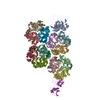
|
|---|---|
| 1 | x 60
|
| 2 |
|
| 3 | x 5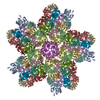
|
| 4 | x 6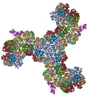
|
| 5 | 
|
| Symmetry | Point symmetry: (Schoenflies symbol: I (icosahedral)) |
- Components
Components
| #1: Protein | Mass: 56245.621 Da / Num. of mol.: 13 / Fragment: SEE REMARK 999 / Source method: isolated from a natural source / Source: (natural)  Sputnik virophage (virus) / References: UniProt: B4YNG0 Sputnik virophage (virus) / References: UniProt: B4YNG0#2: Protein | | Mass: 42703.965 Da / Num. of mol.: 1 / Source method: isolated from a natural source / Source: (natural)  Sputnik virophage (virus) / References: UniProt: I0CES9 Sputnik virophage (virus) / References: UniProt: I0CES9Sequence details | FULL-LENGTH CAPSID PROTEIN V20 (MAJOR CAPSID PROTEIN) WAS PRESENT IN THE SAMPLE, BUT ONLY UNP ...FULL-LENGTH CAPSID PROTEIN V20 (MAJOR CAPSID PROTEIN) WAS PRESENT IN THE SAMPLE, BUT ONLY UNP RESIDUES 1-508 WERE MODELED. | |
|---|
-Experimental details
-Experiment
| Experiment | Method: ELECTRON MICROSCOPY |
|---|---|
| EM experiment | Aggregation state: PARTICLE / 3D reconstruction method: single particle reconstruction |
- Sample preparation
Sample preparation
| Component | Name: Sputnik virus / Type: VIRUS |
|---|---|
| Details of virus | Empty: NO / Enveloped: NO / Host category: EUKARYOTE / Isolate: STRAIN / Type: SATELLITE |
| Natural host | Organism: Acanthamoeba |
| Buffer solution | Name: PBS / pH: 7 / Details: PBS |
| Specimen | Conc.: 2 mg/ml / Embedding applied: NO / Shadowing applied: NO / Staining applied: NO / Vitrification applied: YES |
| Specimen support | Details: 400 mesh copper grid with 1.2 um holes |
| Vitrification | Instrument: GATAN CRYOPLUNGE 3 / Cryogen name: ETHANE / Temp: 100 K / Humidity: 90 % Details: 6 second blot, plunged into liquid ethane (GATAN CRYOPLUNGE 3) Method: 6 second blot |
- Electron microscopy imaging
Electron microscopy imaging
| Experimental equipment |  Model: Titan Krios / Image courtesy: FEI Company |
|---|---|
| Microscopy | Model: FEI TITAN KRIOS / Date: Jan 1, 2011 |
| Electron gun | Electron source:  FIELD EMISSION GUN / Accelerating voltage: 300 kV / Illumination mode: FLOOD BEAM FIELD EMISSION GUN / Accelerating voltage: 300 kV / Illumination mode: FLOOD BEAM |
| Electron lens | Mode: BRIGHT FIELD / Nominal magnification: 59000 X / Nominal defocus max: 2400 nm / Nominal defocus min: 1100 nm / Cs: 2.7 mm |
| Specimen holder | Temperature: 100 K |
| Image recording | Electron dose: 22 e/Å2 / Film or detector model: KODAK SO-163 FILM |
| Radiation | Protocol: SINGLE WAVELENGTH / Monochromatic (M) / Laue (L): M / Scattering type: x-ray |
| Radiation wavelength | Relative weight: 1 |
- Processing
Processing
| EM software |
| ||||||||||||
|---|---|---|---|---|---|---|---|---|---|---|---|---|---|
| CTF correction | Details: each particle | ||||||||||||
| Symmetry | Point symmetry: I (icosahedral) | ||||||||||||
| 3D reconstruction | Method: projection matching / Resolution: 3.5 Å / Resolution method: FSC 0.143 CUT-OFF / Num. of particles: 12000 / Actual pixel size: 1.1 Å / Symmetry type: POINT | ||||||||||||
| Refinement step | Cycle: LAST
|
 Movie
Movie Controller
Controller



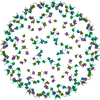
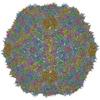

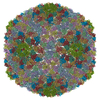



 PDBj
PDBj